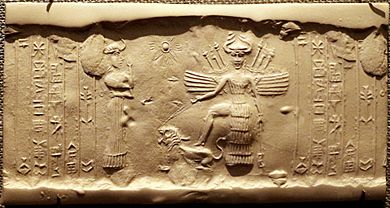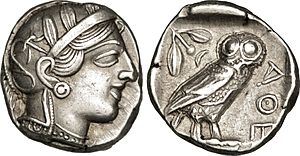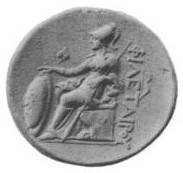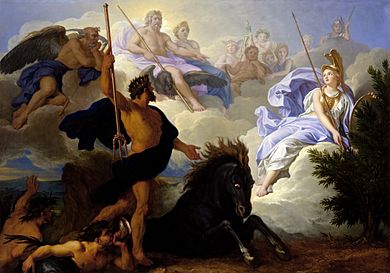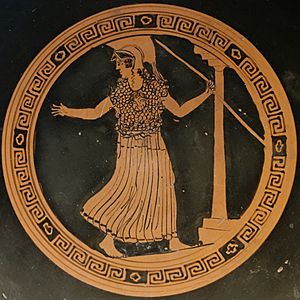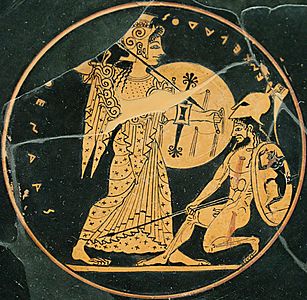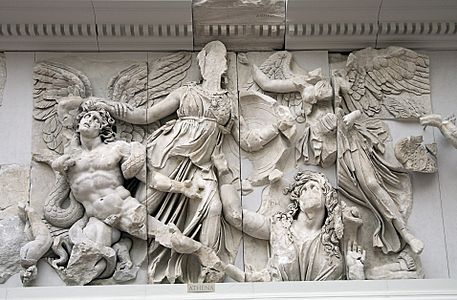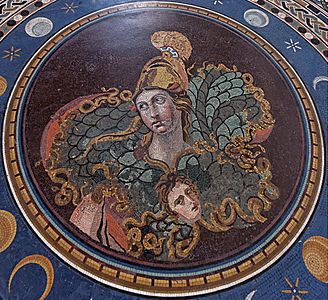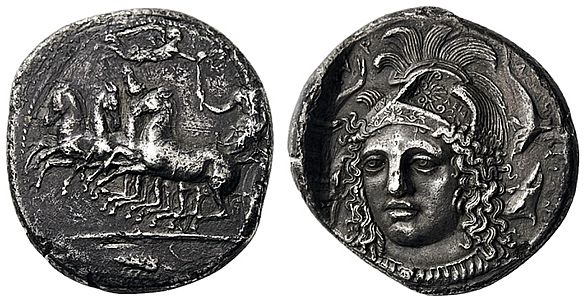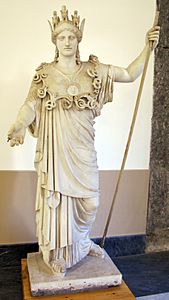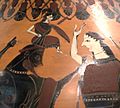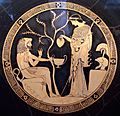Athena facts for kids
Quick facts for kids Athena |
|
|---|---|
| Goddess of wisdom, handicraft, heroism, courage, war, strategy, industry, and cities | |
| Member of the Twelve Olympians | |
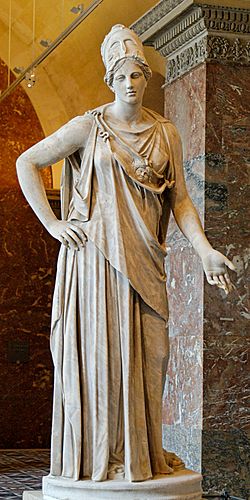
Mattei Athena at Louvre. Roman copy from the 1st century BC/AD after a Greek original of the 4th century BC, attributed to Cephisodotos or Euphranor.
|
|
| Abode | Mount Olympus |
| Animals | owl, serpent, spider, horse |
| Symbol | Aegis, helmet, spear, armor, Gorgoneion, chariot, distaff |
| Tree | Olive |
| Personal information | |
| Children | Erichthonius (adopted) |
| Parents | Zeus and Metis |
| Siblings | Aeacus, Angelos, Aphrodite, Apollo, Ares, Artemis, Dionysus, Eileithyia, Enyo, Eris, Ersa, Hebe, Helen of Troy, Hephaestus, Heracles, Hermes, Minos, Pandia, Persephone, Perseus, Rhadamanthus, the Graces, the Horae, the Litae, the Muses, the Moirai |
| Equivalents | |
| Roman equivalent | Minerva |
| Etruscan equivalent | Menrva |
| Hinduism equivalent | Sarasvati |
| Canaanite equivalent | Anat |
| Egyptian equivalent | Neith |
| Celtic equivalent | Sulis |
Athena or Athene is an important ancient Greek goddess. She is known for wisdom, crafts, and warfare. Later, the Roman goddess Minerva was seen as the same deity. Athena was the special protector of many cities in Greece. The city of Athens was her favorite, and she likely got her name from it. The famous Parthenon temple in Athens is dedicated to her. Her main symbols are owls, olive trees, snakes, and the Gorgoneion. In art, she often wears a helmet and holds a spear.
Athena was originally a goddess who protected palaces and cities. She was called Polias and Poliouchos, meaning "city-state" goddess. Her temples were usually built on the highest, most protected part of a city, called the acropolis. The Parthenon on the Athenian Acropolis is one of her most famous temples. As the patron of crafts and weaving, she was known as Ergane. She was also a strong warrior goddess. People believed she led soldiers into battle as Athena Promachos. The most important festival in Athens was the Panathenaia, celebrated in midsummer for her.
In Greek mythology, people believed Athena was born from the forehead of her father, Zeus. In some stories, she had no mother. In others, like Hesiod's Theogony, Zeus swallowed his partner Metis while she was pregnant with Athena. In this version, Athena was born inside Zeus and then burst out of his forehead. In the story of how Athens was founded, Athena won a contest against Poseidon. She created the first olive tree, which was seen as a better gift for the city. She was also known as Athena Parthenos, meaning "Athena the Virgin." Athena helped many heroes, including Perseus, Heracles, Bellerophon, and Jason. She was also one of the three goddesses whose argument led to the start of the Trojan War.
Contents
What Does Athena's Name Mean?
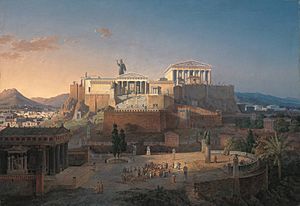
Athena is strongly linked to the city of Athens. The ancient Greek name for the city, Ἀθῆναι (Athȇnai), is a plural word. It refers to the place where, according to myth, Athena watched over the Athenai, a group of women who worshipped her. For a long time, scholars debated if Athena was named after Athens or if Athens was named after Athena. Today, most experts agree that the goddess's name comes from the city. The ending "-ene" is common in place names but rare for people's names.
Ancient Greek cities often had a special goddess who protected them. These goddesses usually took their names from their cities. For example, in Mycenae, there was a goddess called Mykene. At Thebes, the goddess was named Thebe. This shows a common pattern across ancient Greece.
The philosopher Plato (428–347 BC) had some interesting ideas about Athena's name. In his dialogue Cratylus, he suggested that Athena's name might mean "divine intelligence." He thought it came from Greek words meaning "mind of God" or "she who knows divine things." This shows how ancient Greeks connected Athena with wisdom and understanding.
Where Did Athena Come From?
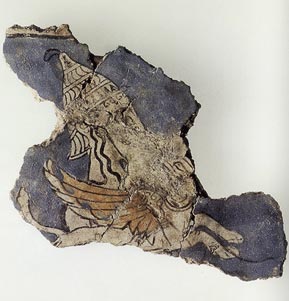
Athena was originally a goddess from the Aegean region. She was seen as the protector of palaces and was in charge of household crafts. An ancient inscription from Knossos mentions "Athana potnia," which could mean "Mistress Athena" or "the Lady of Athana." This is one of the earliest mentions of a name similar to Athena.
Some scholars believe that Athena was first an owl or a bird goddess. In the Odyssey, she even changes into a sea-eagle. Over time, she lost her animal form, and the owl and snake became her symbols instead of her actual shapes. Sometimes, in old vase paintings, she is still shown with wings.
Many experts agree that Athena's worship has roots in ancient Proto-Indo-European beliefs. Her cult may also have been influenced by warrior goddesses from the Near East. These include Ishtar and Anat, who were often shown with weapons. Athena's birth from Zeus's head might even come from an older Sumerian myth about Inanna.
The philosopher Plato also noted that people in Sais, Egypt, worshipped a goddess named Neith. He thought Neith was similar to Athena. Neith was an Egyptian goddess of war, hunting, and weaving. Some theories suggested that Neith's worship came to Greece from Egypt. However, most modern scholars do not support this idea.
How Was Athena Worshipped?
Athena's Role in Greek Cities
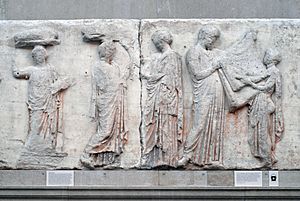
As Athena Polias, Athena was honored as the goddess of the city and the protector of its fortress. In Athens, a festival called the Plynteria was held every year. During this five-day event, priestesses would clean Athena's statue, wash her clothes, and purify her. Athena was also worshipped as Athena Ergane, the patroness of various crafts, especially weaving. She also helped metalworkers make armor and weapons. By the late 400s BC, Athena also became known as the goddess of philosophy.
As Athena Promachos, she was believed to lead soldiers into battle. Athena represented the smart, planned side of war. This was different from her brother Ares, who was the god of violence and bloodshed. Athena was thought to only support those fighting for a fair reason. The Greeks respected Athena much more than Ares. She was especially honored during festivals like the Panathenaea, which featured athletic and military displays. As a protector of heroes, Athena favored those who used cleverness and intelligence.
Athena was known as Parthenos ("virgin") because, like Artemis and Hestia, she was believed to always remain a virgin. Her most famous temple, the Parthenon on the Athenian Acropolis, gets its name from this title. The name Parthenos also showed her role in making sure people followed rules of modesty and sacred rituals.
Athena's Worship in Different Regions
Athena was not just the patron goddess of Athens. She was also worshipped in other cities like Argos, Sparta, and Gortyn. Her different cults helped young Greeks transition into adulthood. For example, young men became citizens, and young women entered marriage. These cults helped create a common way of life across Greece.
In Arcadia, Athena was linked with an old goddess named Alea. She was worshipped as Athena Alea. Her temple in Tegea was a very important religious place. The geographer Pausanias wrote that this sacred area was founded by Aleus.
Sparta also had a major temple for Athena on its Acropolis. There, she was called Poliouchos and Khalkíoikos ("of the Brazen House"). This name might mean her statue was made of bronze, or that the temple walls were bronze, or that she protected metalworkers. An Ionic-style temple for Athena Polias was built in Priene in the 300s BC. Alexander the Great dedicated this temple.
Famous Myths About Athena
A Unique Birth

The story of Athena's birth is one of the most famous in Greek mythology. According to the poet Hesiod, her father, Zeus, was told a prophecy that a child born to his first wife, Metis, would one day overthrow him. To prevent this, Zeus swallowed Metis before she could give birth.
Later, Zeus developed a terrible headache. The pain was so great that he asked the god Hephaestus to split his head open with an axe. From his head sprang Athena, fully grown and dressed in armor, shouting a powerful war cry. The other gods were amazed and awestruck by her arrival.
Protector of Athens
Athena became the patron goddess of Athens after winning a contest against the sea god Poseidon. The two gods agreed that whoever gave the city the better gift would become its protector.
Poseidon struck the ground with his trident, and a spring of salt water appeared. This gift represented sea power and trade. Then, Athena touched the ground with her spear, and the first olive tree grew. The people of Athens, led by their king Cecrops, decided that Athena's gift was more useful. The olive tree provided food, oil, and wood. The city was then named Athens in her honor.
A Helper to Heroes
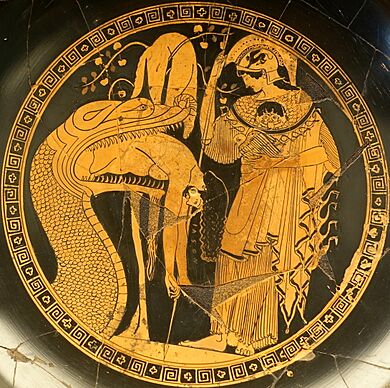
Athena was a great ally to many Greek heroes. She favored those who used their intelligence and courage.
- Perseus: She helped Perseus on his quest to defeat the Gorgon Medusa. She gave him her polished shield so he could see Medusa's reflection without being turned to stone. She also guided his hand as he defeated the monster.
- Heracles: Athena often appeared to help Heracles during his Twelve Labors. She gave him advice on how to defeat the Nemean lion and even helped him hold up the sky.
- Odysseus: In Homer's epic poem, the Odyssey, Athena is the special protector of the clever hero Odysseus. She guided him throughout his long journey home from the Trojan War, often appearing in disguise to offer him advice and help him overcome challenges.
Myths of Punishment
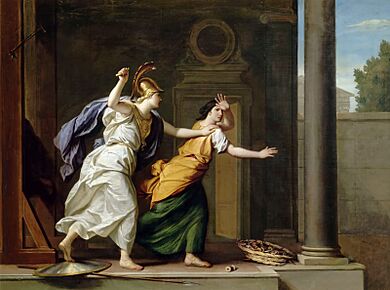
Like other gods, Athena could be stern and would punish humans for disrespect or excessive pride.
- Arachne: A mortal woman named Arachne was a brilliant weaver who boasted that she was even better than Athena. The goddess, disguised as an old woman, warned her not to challenge the gods, but Arachne refused to listen. They held a weaving contest. Athena wove a beautiful tapestry showing the power of the gods. Arachne wove a tapestry that made fun of the gods. Although Arachne's work was perfect, Athena was furious at her disrespect. She destroyed Arachne's work and turned her into a spider, doomed to weave forever.
- Medusa: In a later myth, a woman named Medusa disrespected Athena by meeting with Poseidon inside the goddess's temple. Furious that her sacred space was not honored, Athena transformed Medusa into a fearsome Gorgon with snakes for hair. Anyone who looked directly at Medusa would turn to stone.
The Trojan War
The Trojan War began after a dispute between Athena, Hera, and Aphrodite. At a wedding, the goddess of discord, Eris, threw a golden apple labeled "for the fairest." All three goddesses claimed it. Zeus sent them to the Trojan prince Paris to decide the winner.
Hera offered him power, and Athena offered him victory in battle. But Aphrodite promised him the most beautiful woman in the world, Helen. Paris chose Aphrodite, earning the anger of Athena and Hera. Because of this, Athena sided with the Greeks during the Trojan War and helped them defeat the Trojans.
Athena in Classical Art
Athena appears often in ancient Greek art. You can see her on coins and in paintings on pottery. She is especially common in art made in Athens. In classical art, Athena is usually shown standing tall, wearing a long robe called a chiton. She is often dressed in armor like a male soldier. She wears a Corinthian helmet high on her head. Her shield usually has the aegis in the center, with the head of the gorgon (gorgoneion) and snakes around the edge. Sometimes, she wears the aegis as a cloak. As Athena Promachos, she is shown holding a spear.
Art often shows scenes from Athena's myths. These include her birth from Zeus's head, her battle with the Gigantes, the birth of Erichthonius, and the Judgement of Paris.
The Mourning Athena is a famous relief sculpture from around 470-460 BC. It is thought to show Athena Polias. The most famous classical artwork of Athena was the Athena Parthenos. This was a huge, 11.5-meter tall statue made of gold and ivory by the sculptor Phidias in the Parthenon. It is now lost, but copies show Athena holding her shield in her left hand. Nike, the winged goddess of victory, stood in her right hand. The Roman goddess Minerva took on most of Athena's symbols and was part of the Capitoline Triad in Rome.
-
Attic red-figure kylix of Athena Promachos holding a spear next to a Doric column (around 500-490 BC).
-
Restoration of the colors on the Athena statue from the Aphaea temple at Aegina, around 490 BC.
-
Relief of Athena and Nike slaying the Gigante Alkyoneus from the Gigantomachy Frieze on the Pergamon Altar (early 2nd century BC).
-
Classical mosaic from a villa at Tusculum, 3rd century AD, now at Museo Pio-Clementino, Vatican.
-
Athena portrait by Eukleidas on a tetradrachm from Syracuse, Sicily around 400 BC.
-
Athena (2nd century BC) in the art of Gandhara, displayed at the Lahore Museum, Pakistan.
Interesting facts about Athena
- Athena was a goddess of war, but specifically of generalship, strategy, and the disciplined, courageous side of combat, in contrast to Ares, who represented bloodlust and violence.
- She was unaging and immune to death or disease.
- Like the goddesses Artemis and Hestia, Athena never married or had children of her own.
- Her main symbols are the owl, the olive tree, and the snake.
- In art, she is almost always shown wearing a helmet and carrying a spear.
- The Romans identified her with their goddess Minerva.
Images for kids
-
Athena is "born" from Zeus's forehead after he swallowed her mother Metis. Zeus grasps the clothing of Eileithyia on the right; black-figured amphora, 550–525 BC, Louvre.
-
The Varvakeion Athena, the most faithful copy of the Athena Parthenos, displayed in the National Archaeological Museum, Athens.
-
The Dispute of Minerva and Neptune by René-Antoine Houasse (around 1689 or 1706).
-
Attic red-figure kylix painting from around 480-470 BC showing Athena watching as the Colchian dragon releases the hero Jason.
-
Classical Greek depiction of Medusa from the 4th century BC.
-
Minerva and Arachne by René-Antoine Houasse (1706).
-
Ancient Greek mosaic from Antioch dating to the 2nd century AD, depicting the Judgement of Paris.
-
Silver coin showing Athena with Scylla decorated helmet and Heracles fighting the Nemean lion (Heraclea Lucania, 390-340 BC).
-
Pallas and the Centaur (around 1482) by Sandro Botticelli.
-
Minerva Expelling the Vices from the Garden of Virtue (1502) by Andrea Mantegna.
-
Pallas Athena (around 1655) by Rembrandt.
-
Minerva and the Triumph of Jupiter (1706) by René-Antoine Houasse.
-
Minerva Fighting Mars (1771) by Jacques-Louis David.
-
Minerva of Peace mosaic in the Library of Congress.
See also
 In Spanish: Atenea para niños
In Spanish: Atenea para niños



